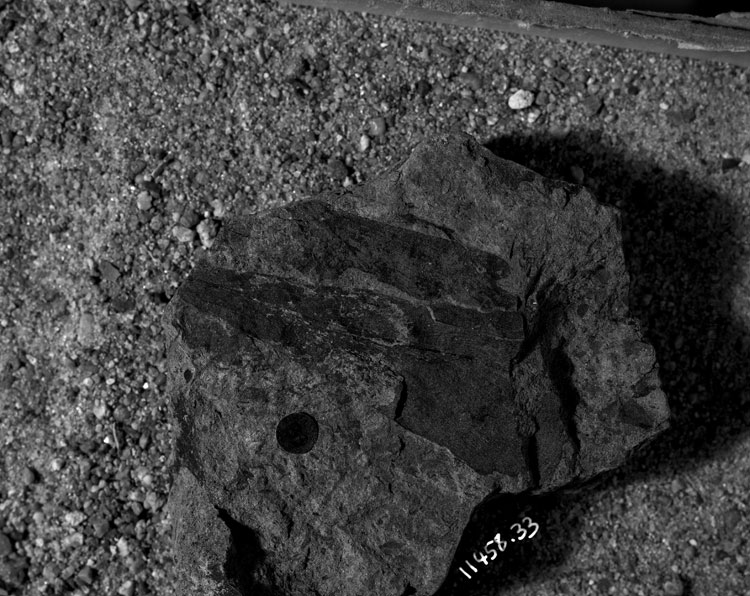Locality
USGS11614
Lat. 60° 36' 36"N Long. 164° 49' 18"W
Baird Inlet (C-8) Quad. Nelson Island.
Description
Leaves or phylloclades: very variable in size and shape; undulate or irregular to lobate, petiolate, petiole long or short; apex variable, base acuminate; midvein moderate, usually straight, extending to apex or disappearing in the apical half of the leaf of the leaf; lateral veins or striae straight or nearly so, very numerous and often difficult to trace individually, parallel, arranged at a very acute angle to the midvein.
Remarks
This form is extremely variable. Bell (1957) reports the abundant widespread occurrence of the form in the Nanaimo Group, the only difference between his specimens and those illustrated here being in petiole length. Bell considered all his specimens to have a short petiole, which is obviosly not the case wityh the Alaskan material. This difference might not be a real one, however. Bell considered Protophyllocladus lanceolatus Knowlton (1894; Plate 5, Fig. 5) and Phyllocladus subintegrifolius Lesquereux (1874, Plate 1, Fig. 12; 1892, Plate 2, Figs. 1-3) as conspecific with Protophyllocladus polymorphus. Bell also thought that Thinnfeldia lesquereuxiana Heer might be conspecific but was uncertain because of the smaller size of the leaves. Considering the range of leaf sizes in this form it seems likely that Bell's fears were unfounded and that Thinnfeldia lesquereuxiana should be regarded as Protophyllocladus polymorphus.
Berry (1903) reviewed the then confusing situation that surrounded leaves of this type and made comparisons between the fossil forms and living material of Phyllocladus asplenifolia Hooker. He made a distinction between Triassic, Jurassic and Lower Cretaceous occurrences of leaves ascribed to the genus Thinnfeldia Ettingshausen and similar forms in the middle and Upper Cretaceous for which he erected the genus Protophyllocladus. Protophyllocladus subintegrifolius (Lesquereux) Berry then included those leaves described as Phyllocladus subintegrifolius (Lesquereux 1868, p. 92; 1874, Plate 1, Fig. 12; 1892, Plate 2, Figs. 1-3), Thinnfeldia lesquereuxiana (Heer, 1882, p.37, Plate 44, Figs. 9, 10; Plate 46, Figs. 1-12a, 12b; Newberry, 1896, p. 59, Plate 11, Figs. 1-17; Hollick, 1892, p. 99, Plate 3, Fig. 6; Hollick, 1895, p. 12-14; Hollick, 1898, p. 58, Plate 3, Figs. 4, 5; p.419, Plate 36, Fig. 6), and Thinnfeldia subintegrifolia (Lesquereux) Knowlton (1898, p. 228; Hollick, 1898, p. 403, Plate 41, Figs. 13, 14). The name Protophyllocladus polymorphus (Berry, 1903, p. 442) included Salisburia polymorpha Lesquereux (1859, p. 362, nomen nudum; 1873, p. 404; 1878, p.84, Plate 6, Figs. 40, 41), Thinnfeldia polymorpha Knowlton (1892, p. 153; 1894, p.47, Plate 5i, Figs. 1-4) and Thinnfeldia montana Knowlton (1898, p. 227; 1900, p. 11, Plate 1, Figs. 1-3). Hollick (1930) reported both Protophyllocladus polymorphus and Protophyllocladus subintegrifolius from his Yukon River localities.
It is clear that this form is widespread geographically and occurs throughout the Upper Cretaceous in North America.
